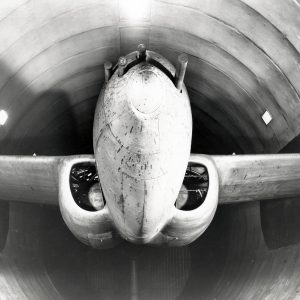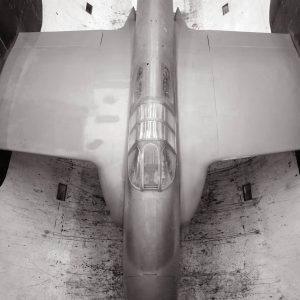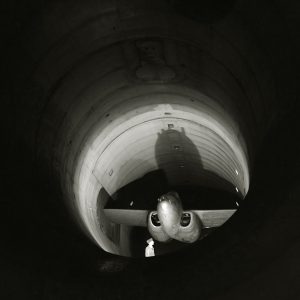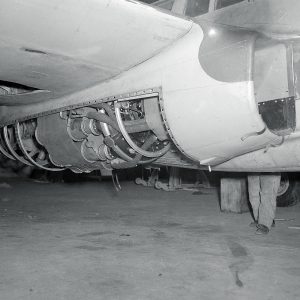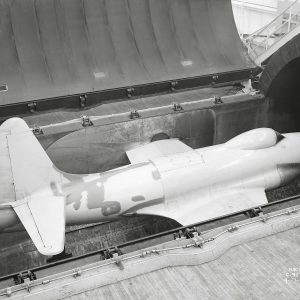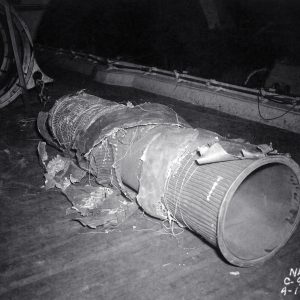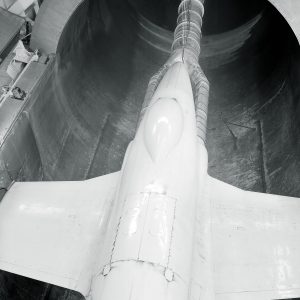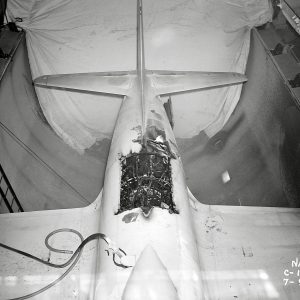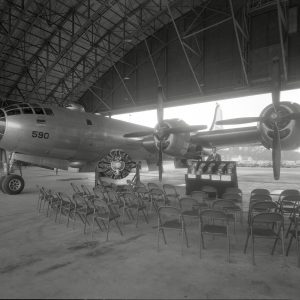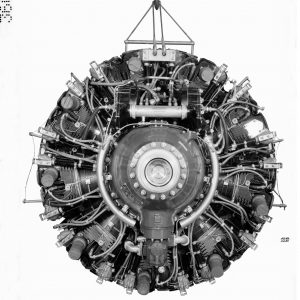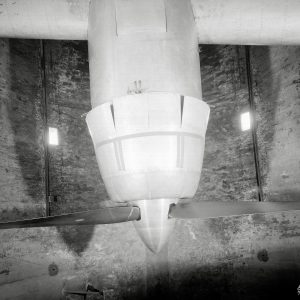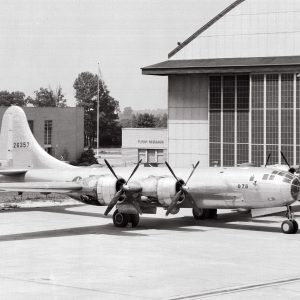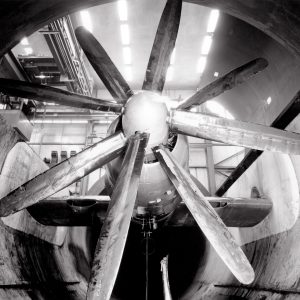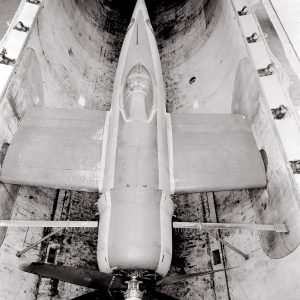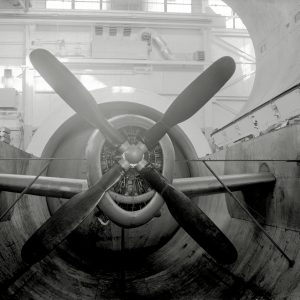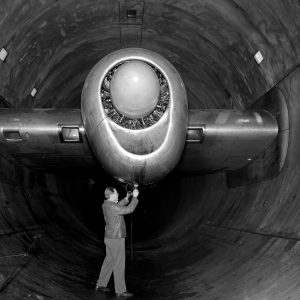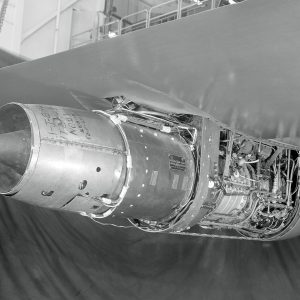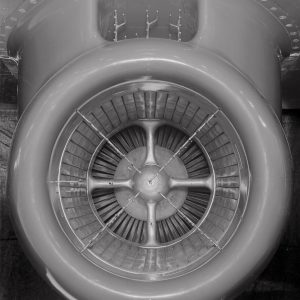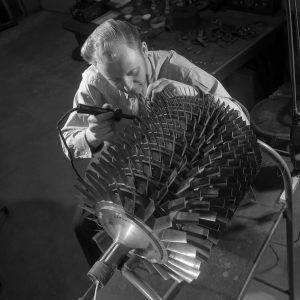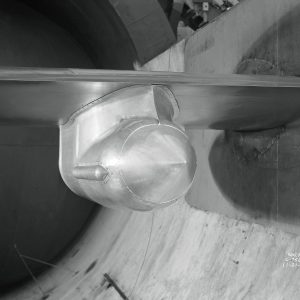AWT’s World War II Efforts
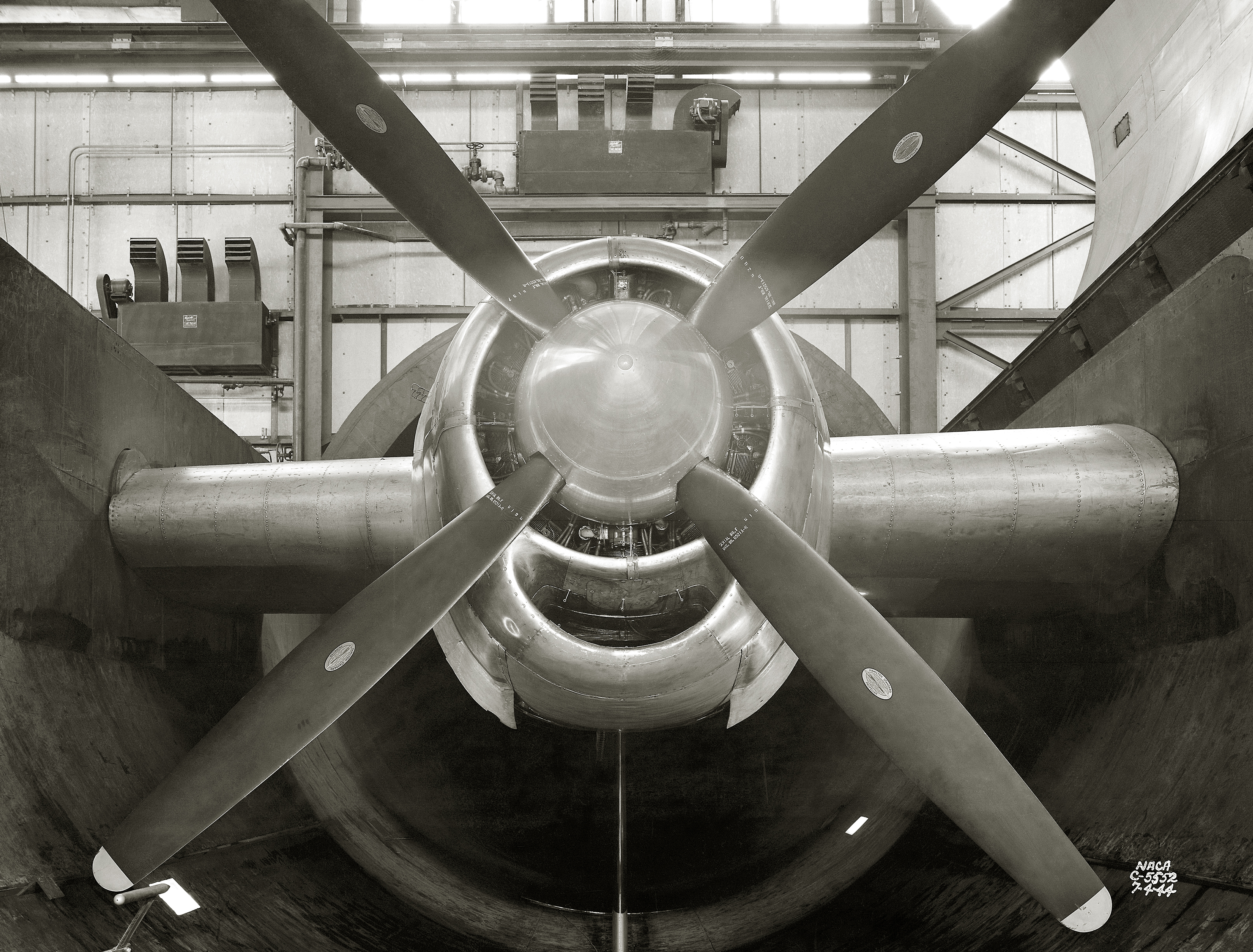
The AWT began operation in 1944 and contributed to the World War II effort by resolving the B-29 bomber’s engine cooling problems and testing the nation’s earliest jet engines.
Overview
World War II was the first war in which aircraft played a dominant role. At the time, a relatively small number of reciprocating (piston) engine models powered all U.S. military aircraft. The Aircraft Engine Research Laboratory (AERL)’s was initially charged with the improvement of the piston engines. The AERL possessed a number of test stands, dynamotors, and laboratories, but the Altitude Wind Tunnel (AWT) was its centerpiece. The War Department’s William Knudson explained, “The high-altitude wind tunnel is especially needed to solve problems in connection with the cooling and power output of engines in combat planes required to fight at altitudes of 40,000 to 50,000 feet.”
The AWT analyzed several types of piston engines during the last two years of the War, most notably, the Curtiss-Wright R-3350s that powered Boeing’s new B-29 Superfortress. Despite the NACA focus on piston engines, however, the majority of the AWT’s wartime investigations involved a new, more powerful type of engine̶—the turbojet (gas turbine). In fact, the very first test in the new tunnel investigated a Bell YP-59A aircraft and its two General Electric (GE) I-16 jet engines.
Documents
- Altitude Wind Tunnel Projects (1944-45)
- AWT Test Schedule (1945)
- Log of AWT Investigations (1944-58)
- General Arnold’s Visit to the AERL (1944)
- Trouble-Shooting: The Wartime Mission from Engines & Innovation (1991)
GE Centrifugal Jet Engines
The concept of jet propulsion dates back hundreds of years, but its application to aircraft was not feasible until the 1930s when British engineer Frank Whittle and the German Hans von Ohain independently developed versions of the jet engine. These engines employed large a centrifugal compressors. Germany first flew their version in August 1939, and the British in May 1941.
General Henry “Hap” Arnold, Head of the US Air Command, witnessed the British flight and made arrangements to secretly bring Whittle’s design back to the United States. GE struggled to transform the drawings into the I–A engine. Bell Aircraft incorporated two I–As into its XP–59A Airacomet. The aircraft’s poor performance in October 1942 spurred GE to update the design as the I–16. The ensuing flight tests in August 1943 again did not meet expectations. The military made arrangements for the AERL to test the I–16 in its Jet Propulsion Static Laboratory and new AWT.
In January 1944, a YP–59A flew into Cleveland for the tests. Mechanics cut the wingtips and tail from the aircraft so it would fit inside the AWT’s test section. On February 4, researchers began testing the I–16 engines at different altitudes. They then redesigned boundary layer removal duct, nacelle inlets, and cooling air seals. Ensuing tests demonstrated that the improved airflow distribution reduced drag and increased engine performance by 25-percent. Despite these enhancements, the YP–59A remained too problematic for combat in World War II, and the design was eventually abandoned. The I–16, however, served as the basis for future successful jet engines.
Documents
- The Case for Jet Propulsion chapter from Engineer in Charge
- Research Authorization for AWT Test of I–16 Engine (1944)
- AWT Tests of a Jet-Propelled Fighter (1946)
After the disappointment of Bell’s YP–59A, the military contracted with Lockheed in 1943 to design a new jet fighter (XP–80A Shooting Star) that would employ GE’s latest jet engine. This 4,000-pound thrust I–40 was more than twice as powerful as the I–16. The aircraft’s accelerated development in 1944 led to operational problems and crashes during its early flights.
In the spring of 1945, NACA researchers installed an YP–80A in the AWT to study the performance of the I–40 engines at altitudes up to 50,000 feet. They also addressed specific issues such as high-altitude restarting, adjustable tailpipe nozzles, and engine stalls. The investigations resulted in the first restarting of the engine above 20,000 feet and the use of a variable-area nozzle to instantaneously boost thrust by 50-percent. The researchers were also able to develop a curve that would allow data from future I–40 tests at sea level to be scaled to altitudes.
The YP–80A Shooting Star was the first complete jet aircraft manufactured in the US and the nation’s first jet aircraft to fly faster than 500 miles per hour. The Shooting Star did not make much of a contribution to World War II, but its reincarnation as the F–80 was used widely at the onset of the Korean War.
Documents
- Plan for GE I–40 Tests in the AWT (1944)
- Windmilling Drag in I-40 Engine (1948)
- I–40 Compressor Performance (1948)
- I–40 Operation Investigation (1948)
- Investigation of Turbine and Tailpipe in I–40 (1948)
R–3350 and Other Piston Engines
The military contracted with Boeing to develop a high-altitude daytime bomber that would supersede the B–17 Flying Fortress. The resulting B–29 Superfortress was powered by four Curtiss-Wright R–3350 2200 horsepower reciprocating engines. Although development of the R–3350s began in the mid-1930s, the engines were plagued with problems when incorporated into the B–29 design in 1942. Despite this, and many other problems with the aircraft itself, the military rushed the Superfortresses through production. One of the most serious problems was the overheating and burning up of the R–3350s when the B–29 climbed to the high altitudes at which it was intended to operate.
The Air Command summoned the new AERL to investigate and solve the overheating problem. There were engine tests conducted in many of the AERL’s facilities, but the key studies occurred from May to September 1944 in the AWT’s simulated altitude conditions. Researchers determined the cooling problems stemmed from inconsistent fuel mixtures and poor air flow through the engine. By devising a fuel injection system and redirecting the air flow through the engine’s cylinders, the AERL researchers were able to increase the fuel efficiency by 18-percent. This broadened the B–29s flight range and increased its armament capabilities. The modifications were incorporated into post-war models of the R–3350.
Documents
- Investigation of Cowl for the B–29 Powerplant Installation (1946)
- B–29 Flight Test of Injection Impeller and Ducted Baffles (1945)
The AERL staff also used the AWT to test several other piston engines for military aircraft during World War II. The first was the experimental torpedo bomber—the Douglas XTB2D–1 Skypirate, which was powered by Pratt & Whitney’s R-4360 engine. In late 1944, researchers studied aerodynamic issues of the engine cowl, carburetor, and the oil cooler in the AWT. In August 1945, the AERL studied four different propellers on a Republic YP–47M fighter in the AWT. The researchers developed curves to determine maximum efficiency and the distribution of thrust loading along the propeller blades. In October 1945 the AWT was used to study engine temperature of an R–4360 engine for Lockheed’s XR-60 Constitution. The Skypirate and Constitution failed to make it beyond the prototype stage before the War ended in the fall of 1945. The YP–47Ms saw some action in Europe but continued to have problems at the War’s end.
Documents
- Propeller Study with YP–47M Airplane (1946)
- Oil System Investigation with XTB2D–1 Airplane (1946)
- R-4360 Testing for XR–60 Airplane (1947)
Westinghouse’s Jet Engines
As GE was developing its early centrifugal turbojets, Westinghouse began work on a jet engine employing an axial-flow compressor. German engineers employed axial-flow engines in their successful Messerschmitt Me–262 fighter jet. In response to a November 1941 military request, Westinghouse developed the 6-stage 19A engine. In early July 1943, the 19A became the first operational U.S.-designed jet engine. A Chance-Vought FG–1 Corsair first flew the 19A (as a jet-assisted-takeoff-like booster) on 21 January 1944.
In March 1943, Westinghouse began work on an improved version, the 19B. As the 19B was going through its first runs in March 1944, the Navy requested an even more powerful version. Westinghouse created the 10-stage 19XB. AERL researchers used the AWT to test both the 19B and 19XB in the fall of 1944. They conducted general performance studies while modifying the fuel nozzles and combustion chambers. The 19B models suffered combustion blowouts and had difficult restarting at altitude, but the previously untested 19XB versions performed well and restarted consistently at altitudes up to 35,000 feet.
The 19XB (J30) powered the XFD–1 Phantom, the US Navy’s first fighter jet, and the 19B was incorporated into the unique Douglas XB–42A Mixmaster and Northrop XP–79 aircraft.
Documents
- Authorization of 19B Tests in AWT (1944)
- Westinghouse 19B and 19XB Operation (1948)
- Westinghouse 19B and 19XB Compressor (1948)

